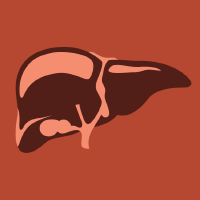Topic Menu
► Topic MenuTopic Editors




Signaling Pathways in Liver Disease

Topic Information
Dear Colleagues,
Acute and chronic liver diseases are complex disorders driven by a variety of pathogenic signal transduction processes. These modulate the biology of parenchymal and non-parenchymal liver cells. Most important are cytokine and chemokine networks that orchestrate an inflammatory response leading to the recruitment and activation of distinct leukocyte subsets. Moreover, the different molecular mediators target specific signaling branches that lead to increased formation of extracellular matrix. Simultaneously, different classes of reactive species are formed, resulting in enhanced oxidative- and nitrosative stress, and liver cell damage. Persistent liver damage results in sequential progression from inflammation to fibrosis, cirrhosis, and hepatocellular carcinoma. Currently, there is a great deal of basic and clinical research ongoing, even at the single-cell level, to interrogate core molecular pathways underlying hepatic disease. We cordially invite you to contribute, in the form of original research articles, reviews, or shorter perspective articles, on all aspects related to the theme of “Signaling Pathways in Liver Disease”. Expert articles describing mechanistic, functional, cellular, biochemical, or general aspects of acute and chronic hepatic disease are highly welcome.
Prof. Dr. Ralf Weiskirchen
Dr. Ruchi Bansal
Prof. Dr. Gabriele Grassi
Prof. Dr. Leo A. Van Grunsven
Topic Editors
Keywords
- cytokine
- chemokine
- growth factor, kinases, liver disease
- fibrosis
- cirrhosis
- hepatocellular carcinoma
- therapy
- biomarker
- non-alcoholic fatty liver disease
- alcohol-associated liver disease
Participating Journals
| Journal Name | Impact Factor | CiteScore | Launched Year | First Decision (median) | APC |
|---|---|---|---|---|---|

Cells
|
5.1 | 9.9 | 2012 | 17 Days | CHF 2700 |

International Journal of Molecular Sciences
|
4.9 | 8.1 | 2000 | 16.8 Days | CHF 2900 |

Journal of Molecular Pathology
|
- | - | 2020 | 26.5 Days | CHF 1000 |

Livers
|
- | 2.0 | 2021 | 27.2 Days | CHF 1000 |

Pathogens
|
3.3 | 6.4 | 2012 | 15.3 Days | CHF 2200 |

Bioengineering
|
3.8 | 4.0 | 2014 | 16.4 Days | CHF 2700 |

MDPI Topics is cooperating with Preprints.org and has built a direct connection between MDPI journals and Preprints.org. Authors are encouraged to enjoy the benefits by posting a preprint at Preprints.org prior to publication:
- Immediately share your ideas ahead of publication and establish your research priority;
- Protect your idea from being stolen with this time-stamped preprint article;
- Enhance the exposure and impact of your research;
- Receive feedback from your peers in advance;
- Have it indexed in Web of Science (Preprint Citation Index), Google Scholar, Crossref, SHARE, PrePubMed, Scilit and Europe PMC.

